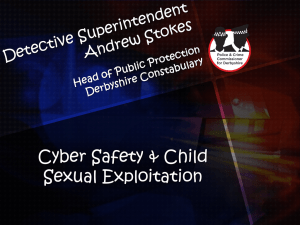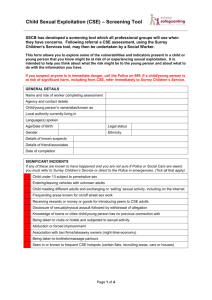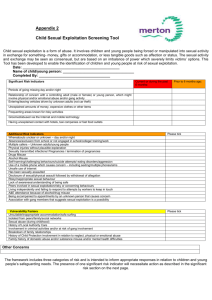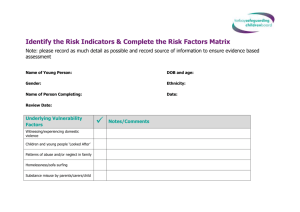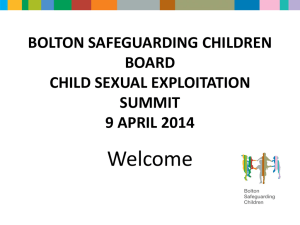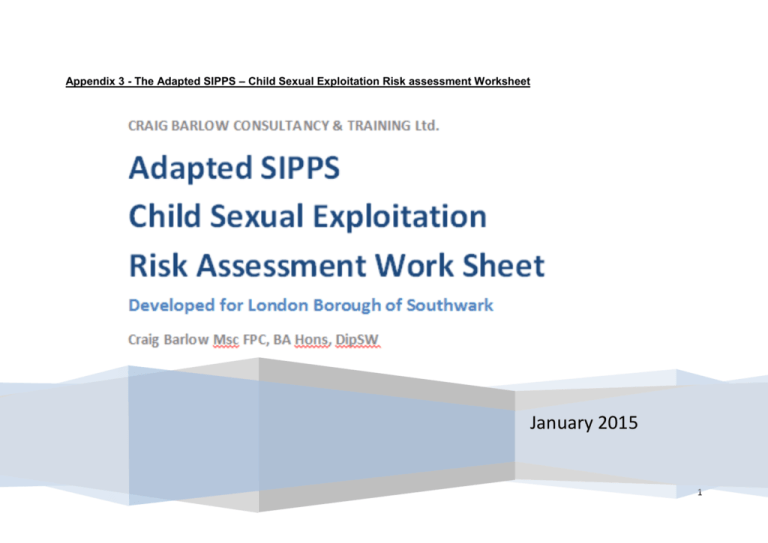
Appendix 3 - The Adapted SIPPS – Child Sexual Exploitation Risk assessment Worksheet
January 2015
1
This worksheet and accompanying guidance manual is a part of the CSE Training Programme designed and delivered by Craig
Barlow.
Permission is given for the worksheets and guidance manual to be reproduced for use within organisations that have purchased the
associated training. It may not be reproduced in whole or in part for distribution to other agencies or organisations without the prior
consent of the Author or the Author’s representatives.
The worksheets and guidance should not be altered in whole or in part without prior agreement or in consultation with the Author.
The Training programme remains the property of Craig Barlow and Craig Barlow Consultancy & Training Ltd.
© Craig Barlow January 2015-01-27
Milton Keynes
Buckinghamshire
United Kingdom
Contact craig.barlow@talktalk.net Tel: 07988 360291
2
A Model of Assessment and Intervention
________________________________________________________________
A Theoretical Framework
Why Do We Need A Theoretical Framework?
Information concerning CSE has been generated from quantitative and qualitative research, news reports, practice experience of
professionals and the personal accounts of victims. This information can always be interpreted in a variety of different ways which
leads to the formation of different kinds of knowledge. Furthermore, knowledge is used differently depending on the needs of the
user e.g. the needs of The Home Office may differ from the needs of a NGO which differ again from the needs of law enforcement
and statutory agencies such as Local Authorities. Therefore there is a great deal of knowledge available to us but it is rather like
having all the pieces of a jigsaw in a bag; the whole picture is in there somewhere but no-one knows quite what it’s meant to look
like. Thus, knowledge alone is not enough. We need theory. Theory goes beyond description to provide explanations, it provides a
framework that enables us to understand and make sense of observations, find explanations make informed judgements and
interventions (Coulshed & Orme, 2012).
A Systemic Perspective on CSE.
At present there are difficulties associated with how CSE and trafficking cases are identified and differentiated from other crimes
such as prostitution. This problem has been reflected internationally. Due to the fact that Trafficking and exploitation involves
hidden communities, it has been extremely difficulty for researchers to obtain sample groups that are representative of trafficked
and exploited groups as a whole. Furthermore there has been very little research on trafficking and exploitation in the Middle East,
Africa and the Americas and the lack of research in general could be attributable to a lack of agreement concerning what exactly
should be studied (Tyldum & Brunovskis, 2005).
In the UK the Modern Slavery Bill1 has finally offered a statutory response to the trafficking of human beings, slavery, servitude and
exploitation of children and adults. It provides a legal process by which we can identify, prevent, investigate and prosecute these
dreadful crimes against vulnerable people. However, to do so requires some understanding of the complexities of such cases; the
varied forms of exploitation, vulnerabilities, interpersonal dynamics, roles, responsibilities and so on.
1
The Modern Slavery Bill is expected to receive Royal assent and enactment in May 2015
3
The exploitation of vulnerable children does not happen in a vacuum. A single case of CSE happens in the context of a
sophisticated system that is made up of many people with different roles and functions. Protective agencies are also a part of that
system. Tackling CSE therefore requires that we understand the nature of the problem from a systemic point of view: actions in any
part of that system or network will have an effect throughout the whole of the network.
Reliance upon traditional methods of investigation and safeguarding of children in the context of any kind of organised exploitation
is inadequate to the task. Existing methodologies are reactive; they are dependent upon the identification of or disclosure of abuse,
an identifiable victim and perpetrator – the abuse has been detected and investigation and intervention follows an inductive or “top
down” process to explain what happened, how it happened and how it will be remedied.
CSE, by its nature is covert and its victims are often hidden. Children and young people that have been sexually exploited do not
necessarily know they’ve been, and if they do, may feel embarrassed about their predicament and do not trust law enforcement or
social care agencies enough in order to report their situation. Indeed, some children and young people that are victims of sexual
exploitation have been arrested numerous times for other offences such as prostitution, public order offences and petty crime
before their real status has been recognised.
The level of violent coercion used by those that traffic and exploit children and young people is often under-estimated. Fear of
retribution from perpetrators prevents disclosure and often causes victims to deny that they have been trafficked, falsely imprisoned
or forced into sex work. The hidden nature of trafficking and sexual exploitation means that victims are kept in isolation and are
often trapped by or dependent upon the abusers. Those trafficked from outside the country may be trafficked illegally and find
themselves treated as illegal immigrants by police and border agencies before their real situation is realised. Other vulnerabilities,
such as physical, cognitive and emotional disabilities, as well as language barriers have in some cases precluded trafficked people
seeking help.
As we saw in Part 1 CSE is a wide reaching term that is essentially about the varied exploitation of vulnerable children, from and
within a variety of contexts. It is a conduit to abuse but one that relies upon the mutual co-operation of those that trade and use
children, the utilisation of legal loopholes, the inherent weaknesses and gaps within organisational structures and protocols, the
corruption of officials and coercion of the victims.
As a secret or hidden phenomenon it is surrounded by myths, assumptions and false perceptions. All these elements coalesce to
form complex eco-systems in which abuse and exploitation is maintained. Like any ecosystem, CSE is constantly changing,
adapting to new pressures and opportunities but at the same time maintaining coherence: changes in the various elements fit
together to meet the needs and goals of the group that is perpetrating the abuse. This therefore has implications for all agencies
working to identify, prevent, investigate and prosecute cases of Child Sexual Exploitation.
4
Instead of simply focusing upon the victim there needs to be recognition that the victim, their abusers and those agencies form a
larger system. An effective response to CSE therefore cannot be one that “Gives” an intervention to the victim but rather one that
promotes movements or perturbations in the entire system, identifies the effects and reveals the next relevant step in the enquiry
(Dallos, 1992). What this comes down to is a change in our approach whereby we become more exploratory, looking for
connections, themes and dependencies. Gradually, as the reality and extent of the case becomes clear, key members and
mechanisms of the network are identified (whether they are perpetrators or victims), relationships and dependencies become
understood and motivations and modus operandi emerge. By so doing we can simultaneously protect actual and potential victims,
identify, disrupt and remove offenders and improve safeguarding and prosecutorial outcomes and reduce the risk of revictimisation.
An Emergent Constructivist Model of Assessment and Intervention
This Course and Guide provides practitioners with a new approach to the assessment of and intervention in cases of CSE. It draws
on the Systemic Investigation, Protection and Prosecution Strategy (SIPPS) (Barlow, et al., 2015) and begins with the systematic,
inductive approach to collecting and, importantly, analysing information in order to develop the next question towards a theory of
what has or is happening. This approach enables practitioners to account for the unpredictable dynamics of the abusive and
exploitative relationship.
The model has 4 fundamental tenets:
1.
2.
3.
4.
Minimising preconceived ideas about the case and its characteristics.
Simultaneously uses information gathering and analysis to inform each other.
Remains open to varied explanations and/or understandings of the information
Focuses on information analysis to construct middle-range theories
(Charmaz, 2008)
When a systematic, comparative, and interactive approach is taken to the initial part of the assessment (gathering the immediate
information and identifying the main concern) open ended strategies begin to emerge: The assessor / investigator can make
conjectures and check them against empirical data and with colleagues and witnesses. This inevitably leads to deductive reasoning
as the assessment / investigation proceeds. It prompts early analytic thinking and keeps practitioners interacting with their
information and sources as well as their initial, loosely formed analysis.
The assessor / investigator must:
5
I.
II.
Be prepared to entertain a range of theoretical possibilities.
Examine their own epistemological premises, principles and practices.
For this reason, our CSE Risk Assessment tool does not provide a rigid list of “Signs and Signals” and numerical rating systems or
risk categories. Rather the items should be used as an aide memoir, prompting thought and analysis of the available information
and using this to undertake the next step in their enquiry (finding gaps and questions, identifying the next relevant source of
information).
The items and descriptors should prompt the assessor to identify themes within the information and categories that relate to the
main concern. The Worksheet facilitates the assessor / investigator in writing progressively analytic (as opposed to descriptive)
notes and records.
Our model emphasises that CSE can be placed upon both a temporal and developmental continuum.
It presupposes a past: Child Sexual Exploitation does not happen in a vacuum, it exists because there is a demand for it and
some children may be more likely to be exploited than others. Therefore it is crucial to make sense of the context from which
the child and abuser have come. The context provides the “Conditional” Factors that contribute to the existence of a situation
in which abuse can occur.
It assumes the immediacy of the present and the situation or context in which all the protagonists now find themselves: How
do they make sense of their predicament, what are their beliefs and relationships to and with each other? In this regard
direct interaction with children, their support networks and even the perpetrators is essential to understand their respective
constructs and this requires us to listen to and analyse the discourse of Child Sexual Exploitation.
Finally, this model implies a future: What will happen in the short, medium and long term both with and without intervention?
What are the most likely scenarios? What needs to happen in order to keep the child or children safe and reduce the
likelihood of re-victimisation.
USING THE CSE RISK ASSESSMENT TOOL
6
Nature and Goals of the CSE Risk Assessment.
CSE incorporates acts of sexual and non-sexual violence and intimidation. The acts can vary with respect to such things as
relationship to the victim(s), severity of physical or psychological harm, use of weapons and implements, motivations etc. This
can include implicit threats (e.g. the victim felt threatened and reasonably believed that the other person had present ability to
cause them harm).
Child Sexual Exploitation Risk Assessment is defined as the process of evaluating individuals in order to:
1. Characterise the risk threat that a child will be sexually Exploited
2. Develop interventions to manage and reduce that risk
(Webster, et al., 1997)
The focus should then be on decision making about what the individuals were trying to achieve and not simply what happened. It
is the task of professionals to understand how and why a person has come to be harmed or to harm others in the past in order to
determine whether the antecedents to that event might lead to similar events re-occurring.
The ultimate goal is the prevention of child sexual exploitation and resultant harm. This assessment procedure aims to be
reliable in terms of replicable, consistent results. It should be used to identify, evaluate and prioritise health, social care and legal
services that can work together to manage the risk of child sexual exploitation.
This process is one of structured professional judgment; it helps professionals make explicit, as far as possible, the basis for
their opinions, decisions and interventions (Webster, et al., 1997).
Scope
The CSE Risk Assessment tool is not a test or scale in the usual sense of the terms. Its purpose is not to provide an absolute or
relative measure of risk using cut-off scores or norms as do actuarial tests such as psychometrics and other non-discretionary
7
assessment tools including JSOAP and Risk Matrix 2000 SVC, although such data can be used to contribute to the overall
assessment. The CSE Assessment Tool is designed to be accessible and useful to practitioners engaged in the assessment of
risk in the child safeguarding arena.
The CSE Risk Assessment Tool is a structured risk assessment protocol intended principally for use in the assessment of risk of CSE
and can be used to contribute to Single Assessments when there are CSE concerns.
The assessment items are based upon empirically-derived risk factors. It contains 26 items that are supported by clinical research
and consensus of practitioner experience. Just like any risk assessment tool, the CSE Risk Assessment therefore remains a
work in progress. As such it marks the start of a process towards achieving risk reducing strategies that flow from the
identification of risk factors that are supported by research evidence. The CSE Risk Assessment and Intervention training
programme has been developed to establish reliability and consistency of approach to implementing the assessment.
It works especially well in the context of multi-disciplinary or team settings and is well suited to the systemic unit model of social
work. Nevertheless it can also be an effective tool for individual practitioners. It can be used as an initial assessment too, or as a
method of monitoring and measuring progress i.e. applying and coding the items periodically during the implementation of safety
plans and direct working with children and families.
The CSE Risk Assessment Tool is a set of guidelines that have been developed to reflect current knowledge within the discipline
of Social Work and Child Safeguarding. The guidelines attempt to define the risk being considered; discuss the necessary
qualifications for conducting an assessment; recommend what information should be considered; and identify a set of core risk
factors that, according to academic and professional literature, should be considered as part of any comprehensive
assessment. By so doing, this tool will improve the consistency and usefulness of decisions, as well as improve the transparency
of decision making.
Key Principles
8
1. The assessment must gather information concerning multiple domains of the child and their family’s functioning. It reflects
the fact that families that are troubled or at risk of Child Sexual Exploitation are not a heterogeneous group. Child Sexual
Exploitation is itself is a multi-faceted problem.
2. The procedure uses multiple methods to gather information: Over-reliance on a particular method can result in an
incomplete or biased assessment.
3. The procedure gathers data from multiple sources because people minimise or deny the harm they have caused or
experienced (Webster, et al., 1997), are under pressure to present a positive self image or significantly over-estimate their
strengths and abilities (Paulhus, 1998): Over-reliance on a particular source can result in an incomplete or biased
assessment.
4. The procedure addresses vulnerability factors in children but also addresses risk factors associated with predatory adults
and victim accessing behaviours.
5. The procedure allows practitioners to judge the credibility of various sources of information, reconcile contradictory
information and judge whether information is sufficient to permit a valid decision.
6. The status of conditional and consequential factors fluctuates over time and such fluctuations can occur rapidly. Risk
assessments should be re-evaluated at regular intervals or whenever there is a change to the status of the case.
7. The procedure aims to be comprehensible to people who must use the findings of the assessment.
8. The prevention of CSE is the primary goal of risk assessment. This procedure goes beyond making static predictions to
develop responsive, flexible interventions.
User Qualifications
9
The CSE Risk Assessment tool is designed to assist in making clinical judgements and formulating safeguarding plans.
Administration and Coding requires professional skill and judgement. It is anticipated that the CSE Risk Assessment Tool
should be used only by professionals with qualifications, training and experience of working within statutory child safeguarding
services.
The CSE Risk Assessment Tool is supported by a specific training programme. Practitioners should undertake the training
prior to administering and coding the tool to ensure reliability and consistency.
10
RISK
_______________________________________________
What are Risk Factors?
A risk factor is a personal characteristic or circumstance that is linked to a negative event that either causes or facilitates the
event to occur and can be categorised thus:
Static Risk Factors: These are unchangeable in that they cannot be influenced by new circumstances or interventions. They
are mostly historic e.g. history of violence, previous experiences of abuse, age etc.
Dynamic Risk Factors: These change over time and can be aspects of the individual or their environment and social context
such as parenting or social deprivation. Because they are changeable, these factors are more amenable to management.
The dynamic risk factors that are quite stable and change slowly are often referred to as Stable or Chronic risk factors. Those
that change rapidly are known as Acute Dynamic Risk Factors or “Triggers” (Department of Health, 2007). Because these
factors change rapidly, their influence on risk may be short lived but require a rapid response (Hart, et al., 2003).
The assessment of risk is the process of gathering information about people in order to make decisions regarding their risk of
being victimised or perpetrators of abuse. That information needs to come from a variety of sources including perpetrator,
victims, collateral sources such as friends and family, other service providers and records and reports (Hart, et al., 2003).
The items within the CSE Risk Assessment Tool consist of Conditional Factors and Consequential Factors.
The procedure gathers the
Historic Conditional (static) Factors,
Current Conditional (Stable dynamic) factors because dynamic factors
Current Consequential (acute dynamic) factors
11
Historic Conditional Factors predispose the child to vulnerability to CSE. They are fixed and cannot be influenced by
intervention or environmental factors.
Present State Conditional Factors aggravate Historical Conditional Factors to increase vulnerability and likelihood of CSE
occurring.
Present State Factors are indicators that CSE is occurring or very likely to occur.
Conditional and Consequential factors are important in respect of evaluating short term or sudden fluctuations in risk and
developing positive safety plans This unique system effectively differentiates between vulnerability factors that increase the
likelihood by contributing to conditions under which CSE can Occur, and Markers for actual CSE.
Risk Management / Safeguarding
Risk Assessment identifies the circumstances in which CSE is most likely to occur and informs strategies to deal with the
most relevant triggers.
A Risk Management or Safety Plan includes an awareness of the potential for changes in the level of risk over time, requiring
an emphasis on the Present State Conditional stable dynamic) and Consequential (acute dynamic) risk factors. (Department
of Health, 2007)
It is vital to understand that perpetrator behaviour (victim selection, victim access patterns, use of physical and psychological
coercion and control, and opportunities to offend) will exacerbate pre-existing vulnerabilities and influence children and young
people’s behaviour, disclosure patterns and on-going protection needs. This has significant implications then for investigation
and intervention.
12
Historic Conditional
Education: Academic performance and behaviour, history of truanting, non-attendance or exclusion, regular breakdown of
school placement, degree of sex education.
Home / Environment: Harmful home environment, Family or personal history of substance abuse, Rigid parenting, Parental
Relationship Instability, Problems from others, Problems with Family, Exposure to De-stabilisers, pattern of street
homelessness
Behavioural: Emotional and behavioural problems (specify), Episodes of going missing /absconding, regular breakdown of
residential placements due to behaviour, Criminal record, impulsivity, history of self harm ,Low mood, low self esteem,
externalised locus of control.
Psychological / Mental Health: History of stress /anxiety, LD, ASD, suicidal ideation, clinical depression,
Physical Health: physical disability, chronic health problems, previous injuries, regular substance abuse, concern for drug
dependency, chronic drug or alcohol use (specially crack or heroine)
Sexual Health : Previous miscarriages, Terminations, STIs
Current Conditional
Education: Changes in attainment /performance, is the child truanting? Is the child not attending or excluded?
Home / Environment: Harmful home environment, Family or personal history of substance abuse, Rigid parenting, Parental
Relationship Instability, Problems from others, Problems with Family, Exposure to Destabilisers, Having access to premises
not known to parent /carer
13
Behavioural: Emotional and behavioural problems (specify), Episodes of going missing /absconding, current placement
breaking down likelihood breaking down due to behaviour, Current criminal activity*, Sexualised Language*, Aggression and
Violence*, Secretive use of Internet and adult networking sites*,Impulsivity, self harming ,Low mood, low self esteem,
externalised locus of control, regularly coming home late, absent without permission / returning late, frequently staying out
overnight without explanation, going missing / absconding, experimenting with drugs /substances, withdrawal from previous
activities, secretive
* Salient in Boys and young men
Psychological / Mental Health: stress /anxiety, LD, ASD, suicidal ideation, clinical depression, memory problems
Physical Health: physical disability, chronic health problems, previous injuries headaches, fatigue, dizziness, stomach and
pelvic pain
Sexual Health: Sexual health anxiety, painful / sore genitalia, STI’s and non-sexually transmitted infections.
Current Consequential
Education: Child is not attending school or is excluded; school placement has broken down due to behavioural problems.
Home / Environment: Unaccounted for monies and or goods (especially mobile phone), associating with unknown adults and
/ or other exploited children, reduced or limited contact with family / friends, no contact with family or friends, abduction or
forced imprisonment, disappeared from system (no contact with support system.
Behaviour: overt sexualised dress / attire**, wearing an unusual amount of clothing*, getting into strangers’ cars, clipping,
extensive use of phone (especially at night), reports from reliable sources, suggesting involvement in sexual exploitation or
14
other forms of exploitation, seen in / picked up in known red light district, disclosure of assault followed by retraction, serious
substance abuse, sexually harmful /offending behaviour*
* Salient in Boys and young men ** Salient in Girls and Young Women
Physical Health: acute and chronic physical injuries (internal and external) e.g.: contusions, lacerations, abdominal trauma,
joint dislocations, mechanical back pain, facial injuries, headaches, fatigue, dizziness, stomach and pelvic pain.
Psychological emotional health: withdrawal, high levels of anxiety and emergence of phobias, PTSD/rape trauma syndrome,
Sexual Health: Genital, lesions, anal lesions, bruising to the back of the throat, dental pain, urination pain, anal bleeding,
vaginal bleeding (not menstruation), amenorrhea / dysmenorrhea, in the case of pregnancy placental abruption.
15
Factors Associated with Suspected or Potential Abusers
Personal Details: Gender, Ethnicity, Name, Nicknames or Alias, Address, Age, Vehicle Make, Model Registration, Colour,
Occupation.
Social Network: Known Associates (include names and nicknames / aliases etc.), connections to other vulnerable or
exploited children.
Environment /Situation: Areas where there young people congregate and there is little or no adult supervision (e.g. Shopping
centres, parks, taxi ranks, train stations, fast food outlets), takes child / young person to adult environments (e.g. pubs, clubs
and bars), Contact with child young person occurs On-line (e.g. web sites and chat rooms and social media).
Police Record: Convictions, Cautions, Warnings and Reprimands, Acquisitive offences, Violent offences inc. Domestic
violence, sexual offences (including making / distributing child abuse images, extreme images and prohibited images), Nonsexual offences against children including neglect, cruelty and abduction, Miscellaneous offences e.g. supply /possession of
drugs, public order offences, perverting the course of justice, harassment, driving offences, possession of an offensive
weapon, criminal damage, arson and supervision breaches.
Behaviour (Overcoming Internal Inhibitions): Cognitive Distortions e.g.: Post Hoc Rationalisation, Objectification of the victim,
Behaviour is legitimised by other offenders within the network, Attitudes e.g. gender and sex role expectations, misogyny,
attitudes that support or condone sexual violence, Generalised anti-social behaviour and attitudes.
Victim Accessing (Grooming): Perceived as an older “Boyfriend”, Sex is exchanged for drugs, alcohol, clothes,
commodities, Introduces victims to a wider group of men in various locations, child believes they owe a debt.
Context of Abuse: Cruise (victim selection, searching out a victim, on foot or in car), Abuse occurred when offender had
already socialised with the victim but not previously sexually abused them; “relationship” escalates to abuse, Recruits via girl
16
(e.g.) “Girlfriend” is coerced into recruiting other girls (usually friends), offender may give specific instructions who to recruit,
Re-Abuse, Offender is a “Pimp” – Motivated to obtain power and respect / reputation from peers.
Coercion and Control: Mobile Phone as gift: Once the victim becomes dependent upon the offender and the phone for
communication, he takes the phone away, Abuse is filmed on mobile phones – images are shared with other offenders and
the victim is blackmailed, Victims often present when peers are abused by the offender group, often in the same room or
somewhere else on the premises, Trafficking between large towns disorientates victim and increases reliance on the
offender, Actual and threatened violence towards victim, threats to harm family, friends or pets if they disclose or do not
comply.
17
CONDITIONAL AND CONSEQUENTIAL FACTORS AND THE CSE
CYCLE
Current Conditional items
do not indicate is
definitely occurring only
that likelihood is
increased
Once Current Consequential
Items are identified they
subsequently become
Historic Conditional Factors
with the implication of
vulnerability to revictimisation
Consequential Items are strongly associated
with the presence of CSE and can be taken
as markers when in clusters or indicators of
greater likelihood if only a few items are
identified
18
Historical Conditional Items
Item includes: Academic performance and behaviour, history of truanting, non-attendance or
exclusion, regular breakdown of school placement, degree of sex education.
EDUCATION
Item includes: Harmful home environment, Family or personal history of substance abuse, Rigid
HOME /
parenting, Parental Relationship Instability, Problems from others, Problems with Family, Exposure to
De-stabilisers, pattern of street homelessness, previous victim of sexual abuse (individual abuser),
previous victim of sexual exploitation (2 or more abusers)
ENVIRONMENT
19
Item Includes: Emotional and behavioural problems (specify) Episodes of going missing
/absconding, regular breakdown of residential placements due to behaviour, Criminal record, impulsivity,
history of self harm, Low mood, low self esteem, externalised locus of control.
BEHAVIOUR
Item includes: History of stress /anxiety, LD, ASD, suicidal ideation, clinical depression.
PSYCHOLOGICAL
/ MENTAL
HEALTH
20
Item Includes: Physical disability, chronic health problems, previous injuries, regular substance
abuse, concern for drug dependency, chronic drug or alcohol use (especially crack or heroine)
PHYSICAL
HEALTH
Item includes: Previous miscarriages, Terminations, STIs.
SEXUAL HEALTH
21
Present State Conditional Items
Item includes: Changes in attainment /performance, child is truanting, child is not attending or excluded.
EDUCATION
Item Includes: Harmful Home Environment, Family Or Personal Engagement in Substance Abuse,
HOME /
ENVIRONMENT
Rigid Parenting, Parental Relationship Instability, Problems From Others, Problems With Family,
Exposure To De-Stabilisers, Having Access To Premises Not Known To Parent /Carer, Older
Boyfriend (5+ Years)
22
Item Includes: Emotional and behavioural problems (specify), Episodes of going missing /absconding, current
placement breaking down likelihood breaking down due to behaviour, Current criminal activity*, Sexualised Language*,
Aggression and Violence*, Secretive use of Internet and adult networking sites*,Impulsivity, self harming ,Low mood, low
self esteem, externalised locus of control, regularly coming home late, absent without permission / returning late,
frequently staying out overnight without explanation, going missing / absconding, experimenting with drugs /substances,
withdrawal from previous activities, secretive
BEHAVIOUR
* Salient in Boys and young men
Item Includes: Stress /Anxiety, LD, ASD, Suicidal Ideation, Clinical Depression, Memory Problems
PSYCHOLOGICAL /
MENTAL HEALTH
23
Item includes: Chronic Health Problems, Previous Injuries Headaches, Fatigue, Dizziness,
PHYSICAL
HEALTH
Stomach and Pelvic Pain.
Item Includes: Sexual health anxiety, painful / sore genitalia, STI’s and non-sexually transmitted
SEXUAL HEALTH
infections.
24
Present State Consequential Items
Item Includes: Child Is Not Attending School Or Is Excluded, School Placement Has Broken Down
EDUCATION
Due To Behavioural Problems.
Item includes: Unaccounted for monies and or goods (especially mobile phone), associating with unknown adults
HOME /
ENVIRONMENT
and / or other exploited children, reduced or limited contact with family / friends, no contact with family or friends, abduction
or forced imprisonment, disappeared from system (no contact with support system.
25
Item Includes: Overt sexualised dress / attire**, Wearing an Unusual Amount of Clothing*, getting into strangers’
cars, Clipping, extensive use of phone (especially at night), reports from reliable sources, suggesting involvement in
sexual exploitation or other forms of exploitation, seen in / picked up in known red light district, disclosure of assault
followed by retraction, serious substance abuse, Sexually Harmful /Offending behaviour*
BEHAVIOUR
* Salient in Boys and young men ** Salient in Girls and Young Women
Item Includes: withdrawal, high levels of anxiety and emergence of phobias, PTSD / Rape Trauma
Syndrome,
PSYCHOLOGICAL
/ MENTAL
HEALTH
26
Item Includes: Acute and Chronic Physical Injuries (Internal and External) E.G: Contusions, Lacerations, Abdominal
PHYSICAL
HEALTH
SEXUAL HEALTH
Trauma, Joint Dislocations, Mechanical Back Pain, Facial Injuries, Headaches, Fatigue, Dizziness, Stomach and Pelvic
Pain.
Item Includes: Genital, lesions, anal lesions, bruising to the back of the throat, dental pain,
urination pain, anal bleeding, vaginal bleeding (not menstruation), amenorrhea / dysmenorrhea, in the
case of pregnancy placental abruption.
27
Suspected Or Potential Abusers
Item includes: Gender, Ethnicity, Name, Nicknames or Alias, Address, Age, Vehicle Make,
PERSONAL
DETAILS
SOCIAL
NETWORK
Model Registration, Colour, Occupation
Item Includes: , Known Associates (include names and nicknames / aliases etc.), connections
to other vulnerable or exploited children,
Consider use of network diagram or eco-map
28
supervision (e.g. Shopping centres, parks, taxi ranks, train stations, fast food outlets), takes child /
young person to adult environments (e.g. pubs, clubs and bars), Contact with child young person
occurs On-line (e.g. web sites and chat rooms and social media).
ENVIRONMENT /
SITUATION
POLICE RECORD
Item includes: areas where there young people congregate and there is little or no adult
Item Includes: Acquisitive offences, Violent offences inc. Domestic violence, sexual offences (including
making / distributing child abuse images, extreme images and prohibited images), Non-sexual offences
against children including neglect, cruelty and abduction, Miscellaneous offences e.g. supply /possession of
drugs, public order offences, perverting the course of justice, harassment, driving offences, possession of
an offensive weapon, criminal damage, arson and supervision breaches.
29
Item Includes: Cognitive Distortions
e.g.: Post Hoc Rationalisation, Objectification of the victim,
Behaviour is legitimised by other offenders within the network, Attitudes e.g. gender and sex role
expectations, misogyny, attitudes that support or condone sexual violence, Generalised anti-social
behaviour and attitudes,
BEHAVIOUR
(Overcoming
Internal Inhibitions)
GROOMING
Item includes: Perceived as an older “Boyfriend”, Sex is exchanged for drugs, alcohol, clothes,
commodities, Introduces victims to a wider group of men in various locations, child believes they
owe a debt.
30
Abuse occurred when offender had already socialised with the victim but not previously sexually abused
them; “relationship” escalates to abuse, Recruits via girl (e.g.) “Girlfriend” is coerced into recruiting other
girls (usually friends), offender may give specific instructions who to recruit, Re-Abuse, Offender is a “Pimp”
– Motivated to obtain power and respect / reputation from peers.
CONTEXT OF
ABUSE
COERCION AND
CONTROL
Item Includes: Cruise (victim selection, searching out a victim, on foot or in car)
Item Includes: Mobile Phone as gift: Once the victim becomes dependent upon the offender and the
phone for communication, he takes the phone away, Abuse is filmed on mobile phones – images are shared
with other offenders and the victim is blackmailed, Victims often present when peers are abused by the
offender group, often in the same room or somewhere else on the premises, Trafficking between large
towns disorientates victim and increases reliance on the offender, Actual and threatened violence towards
victim, threats to harm family, friends or pets if they disclose or do not comply
31
Child Sexual Exploitation Network Diagram
Include connections between suspected or actual Perpetrators, and links with and between victims and other vulnerable children
32
Bibliography
Barlow, C., 2014. FRaSA FAmily Risk and SAfety Assessment. s.l.:CRaig Barlow Consultancy & Training Ltd.
Barlow, C., Haughey, C. & Hafford, M., 2015. SIPPS The Systemic Investgation, Protection and Prosecution Strategy. s.l.:Unpublished.
Charmaz, C., 2008. Graounded Theory as an Emergent Method. In: Handbook of Emergent Methods. New York: The Guilford Press, pp. 155172.
Coulshed, V. & Orme, J., 2012. Social Work Practice. 5th ed. Basingstoke: Palgrave Macmillan.
Dallos, R., 1992. Family Belief Systems, Therapy and Change. Bristol: Open University Press.
Department of Health, 2007. best Practice in Managing risk: Principles and evidence for best practice in the assessment and management of
risk to self and others in mental health services. s.l.:DOH.
Douglas, K. S. et al., 2001. HCR-20 Violence Risk Management Companion Guide. British Columbia: Mental Health, Law and Policy Institute,
Simon Fraser University.
Hart, S. D. et al., 2003. RSVP) Structured Professional Guidelines for Assessing Risk of Sexual Violence. s.l.:MHLPI, Pacific Psychological
Assessment Corp., The British Columbia Institute Against Family Violence.
Paulhus, D. L., 1998. Paulhus Deception Scales: the Balanced INventory of Desirable Responding - 7 User's Manual. s.l.:Multi-Health Systems
inc.
Tyldum, G. & Brunovskis, A., 2005. Describing the Unobserved:Methodological Challenges in Emprical Studies on Human Trafficking. In: F.
Laczko & E. Gozdziac, eds. Data and Research on Human Trafficking: A Global Survey. s.l.:IOM International Organization for Migration.
33

